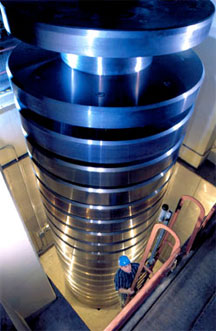| * |
|
Automation Update of Force Laboratory Deadweight Machines
Summary:This project will update all NIST force laboratory automation hardware and software to maintain the current capability of force calibration services. Calibrations conducted at the laboratory’s deadweight force standard workstations are highly dependent on automation systems that were designed and implemented in the late 1980’s. Malfunctions have been appearing in the computers, interface components, and voltage-ratio measuring instrumentation that can no longer be corrected by NIST staff or repair facilities. Simple replacements with current generation instruments cannot be made on an individual unit basis, due to incompatibilities with former generation computers, interfaces, or software. A unified upgrade of these items is necessary to prevent degradation of the service to only those tasks that can be conducted on a manual basis. Description:The automation methods to be followed include a commercially-available interface board which mounts user-selected modules, connections to a current Windows-based computer through a USB port, and equipment control using software generated with the LabVIEW application development system. These enhancements would replace hand-built custom interface boards, large data acquisition and control boxes, and Pascal software programs running on DOS-era computers still in use with the other five force deadweight machine stations. While commercially available, the interface hardware must be manually outfitted with the proper digital inputs and outputs and then physically wired into the current hardware (pumps, switches, lights, etc.). LabVIEW applications must be individually programmed to customize a unique algorithm for each of the five machines. Some machines also present unique challenges; for example, a laser measurement sensor must be evaluated and integrated into the 112 kN machine to replace an antiquated infrared shadow sensor enabling fully automated split-frame operation (which currently is done manually). Additionally, hydraulic pump shutoffs will be incorporated into the automation upgrade of each machine to allow the pumps to be turned off after a calibration is completed (currently they continue running until turned off manually). This effort also includes the verification and transition from outdated precision digital multimeters, currently used to measure the voltage ratio readings from load cell strain gauge bridge networks, to current technology reference multimeters. Hardware testing and software verification for machine control and data acquisition (for each multimeter) are critical and require significant development effort to achieve the required level of data integrity. The primary impact of this work will be to prevent catastrophic and lengthy interruption of NIST force calibration services to customers, who depend upon NIST for traceability in force measurements in all phases of science, industry, and commerce. In addition, improved force calibration efficiencies will result from the automation upgrade, including a greater selection of voltage-ratio measuring instruments and automation of deadweight machine features that currently can only be performed manually. The enhanced automation will also save wear and tear on the hydraulic pumps by allowing shutdown of the hydraulic system after a calibration is complete. Major Accomplishments:
|
 The 4.448 MN (1,000,000 lbf) deadweight machine. Start Date:February 1, 2008Lead Organizational Unit:pmlCustomers/Contributors/Collaborators:Customers:
Collaborators:
Staff:Dr. Zeina J. Kubarych, Program Manager Related Programs and Projects:Contact
Physical Measurement Laboratory (PML) |
